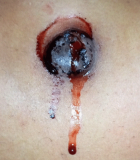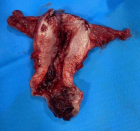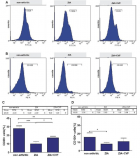Abstract
Review Article
Dapt Review
KARACA Özkan*, KARASU Mehdi, KOBAT Mehmet A and KIVRAK Tarık
Published: 25 March, 2020 | Volume 5 - Issue 1 | Pages: 060-066
Dual antiplatelet therapy (DAPT) combining aspirin and a P2Y12 receptor inhibitor has been consistently shown to reduce recurrent major adverse cardiovascular events (MACE) in patients with acute coronary syndrome (ACS) or undergoing percutaneous coronary intervention (PCI) for stable coronary artery disease (CAD) compared with aspirin monotherapy but at the expense of an increased risk of significant bleeding. Among patients with stable CAD undergoing PCI with drug-eluting stents (DES), shorter duration of DAPT (3–6 months) were shown non-inferior to 12 or 24 months duration concerning MACE but reduced the rates of major bleeding? Contrariwise, prolonged DAPT durations (18–48 months) reduced the incidence of myocardial infarction and stent thrombosis, but at the cost of an increased risk of majör bleeding and all-cause mortality. Until more evidence becomes available, the choice of optimal DAPT regimen and duration for patients with CAD requires a tailored approach based on the patient clinical presentation, baseline risk profile and management strategy. Patients with acute coronary syndromes (ACS) and a history of atrial fibrillation (AF) have indications for both dual antiplatelet therapy (DAPT) and oral anticoagulation (OAC). Triple therapy (TT), the combination of DAPT and OAC, is recommended in guidelines. This article provides a contemporary state-of-the-art review of the current evidence on DAPT for secondary prevention of patients with CAD and its future perspectives.
Read Full Article HTML DOI: 10.29328/journal.jccm.1001088 Cite this Article Read Full Article PDF
Keywords:
Coronary arteries; Antiplatelets; Intervention
References
- Valgimigli M, Bueno H, Byrne RA, Collet JP, Costa F, et al. 2017 ESC focused update on dual antiplatelet therapy in coronary artery disease developed in collaboration with EACTS. Eur J Cardiothorac Surg. 2017; 53: 34-78. PubMed: https://www.ncbi.nlm.nih.gov/pubmed/29045581
- Gwon HC1, Hahn JY, Park KW, Song YB, Chae IH, et al. Six-month versus 12-month dual antiplatelet therapy after implantation of drug-eluting stents: the Efficacy of Xience/Promus Versus Cypher to Reduce Late Loss After Stenting (EXCELLENT) randomized, multicenter study. Circulation. 2012; 125: 505-513. PubMed: https://www.ncbi.nlm.nih.gov/pubmed/22179532
- Palmerini T, Bacchi Reggiani L1, Della Riva D1, Romanello M1, Feres F2, et al. Bleeding-related deaths in relation to the duration of dual-antiplatelet therapy after coronary stenting. J Am Coll Cardiol. 2017; 69: 2011-2022. PubMed: https://www.ncbi.nlm.nih.gov/pubmed/28427576
- Levine GN, Bates ER, Bittl JA, Brindis RG, Fihn SD, et al. 2016 ACC/AHA guideline focused update on duration of dual antiplatelet therapy in patients with coronary artery disease: a report of the American College of Cardiology/American Heart Association Task Force on Clinical Practice Guidelines. J Am Coll Cardiol. 2016; 68: 1082-1115. PubMed: https://www.ncbi.nlm.nih.gov/pubmed/27036918
- Jeppsson A, Petricevic M, Kolh P, Valgimigli M. 2017 European Society of Cardiology (ESC) focused update on dual antiplatelet therapy in collaboration with the European Association for Cardio-Thoracic Surgery (EACTS): Oxford University Press. 2017.
- Bertrand ME, Rupprecht HJ, Urban P, Gershlick AH; CLASSICS Investigators. Double-blind study of the safety of clopidogrel with and without a loading dose in combination with aspirin compared with ticlopidine in combination with aspirin after coronary stenting: the clopidogrel aspirin stent international cooperative study (CLASSICS). Circulation. 2000; 102: 624-629. PubMed: https://www.ncbi.nlm.nih.gov/pubmed/10931801
- Wiviott SD, Braunwald E, McCabe CH, Montalescot G, Ruzyllo W, et al. Prasugrel versus clopidogrel in patients with acute coronary syndromes. N Engl J Med. 2007; 357: 2001-2015.
- Wallentin L, Becker RC, Budaj A, Cannon CP, Emanuelsson H, et al. Ticagrelor versus clopidogrel in patients with acute coronary syndromes. N Engl J Med. 2009; 361: 1045-1057. PubMed: https://www.ncbi.nlm.nih.gov/pubmed/19717846
- Sabatine MS, Cannon CP, Gibson CM, López-Sendón JL, Montalescot G, et al. Addition of clopidogrel to aspirin and fibrinolytic therapy for myocardial infarction with ST-segment elevation. N Engl J Med. 2005; 352: 1179-1189. PubMed: https://www.ncbi.nlm.nih.gov/pubmed/15758000
- Baigent C, Blackwell L, Collins R, Emberson J, Godwin J, et al. Aspirin in the primary and secondary prevention of vascular disease: collaborative meta-analysis of individual participant data from randomised trials: Elsevier. 2009.
- Task Force Members, Montalescot G, Sechtem U, Achenbach S, Andreotti F. et al. 2013 ESC guidelines on the management of stable coronary artery disease: the Task Force on the management of stable coronary artery disease of the European Society of Cardiology. Eur Heart J. 2013; 34: 2949-3003. PubMed: https://www.ncbi.nlm.nih.gov/pubmed/23996286
- Green D. CAPRIE trial. The Lancet. 349(9048). 354-355.
- Bhatt DL, Flather MD, Hacke W, Berger PB, Black HR, et al. Patients with prior myocardial infarction, stroke, or symptomatic peripheral arterial disease in the CHARISMA trial. J Am Coll Cardiol. 2007; 49: 1982-1988. PubMed: https://www.ncbi.nlm.nih.gov/pubmed/17498584
- Schömig A, Neumann FJ, Kastrati A, Schühlen H, Blasini R, et al. A randomized comparison of antiplatelet and anticoagulant therapy after the placement of coronary-artery stents. N Engl J Med. 1996; 334: 1084-1089. PubMed: https://www.ncbi.nlm.nih.gov/pubmed/8598866
- Urban P, Macaya C, Rupprecht HJ, Kiemeneij F, Emanuelsson H, et al. Randomized evaluation of anticoagulation versus antiplatelet therapy after coronary stent implantation in high-risk patients: the multicenter aspirin and ticlopidine trial after intracoronary stenting (MATTIS). Circulation. 1998; 98: 2126-2132. PubMed: https://www.ncbi.nlm.nih.gov/pubmed/9815866
- Mehran R, Pocock S, Nikolsky E, Dangas GD, Clayton T, et al. Impact of bleeding on mortality after percutaneous coronary intervention: results from a patient-level pooled analysis of the REPLACE-2 (Randomized Evaluation of PCI Linking Angiomax to Reduced Clinical Events), ACUITY (Acute Catheterization and Urgent Intervention Triage Strategy), and HORIZONS-AMI (Harmonizing Outcomes With Revascularization and Stents in Acute Myocardial Infarction) trials. JACC: Cardiovascular Interventions. 2011 4: 654-664. PubMed: https://www.ncbi.nlm.nih.gov/pubmed/21700252
- Authors/Task Force members, Windecker S, Kolh P, Alfonso F, Collet JP, et al. 2014 ESC/EACTS guidelines on myocardial revascularization: the Task Force on Myocardial Revascularization of the European Society of Cardiology (ESC) and the European Association for Cardio-Thoracic Surgery (EACTS) developed with the special contribution of the European Association of Percutaneous Cardiovascular Interventions (EAPCI). Eur Heart J. 2014; 35: 2541-2619. PubMed: https://www.ncbi.nlm.nih.gov/pubmed/25173339
- Lorenz RL, Schacky CV, Weber M, Meister W, Kotzur J, et al. Improved aortocoronary bypass patency by low-dose aspirin (100 mg daily): effects on platelet aggregation and thromboxane formation. The Lancet. 1994; 323(8389). 1261-1264. PubMed: https://www.ncbi.nlm.nih.gov/pubmed/6144975
- Mehta SR, Tanguay JF, Eikelboom JW, Jolly SS, Joyner CD, et al. Double-dose versus standard-dose clopidogrel and high-dose versus low-dose aspirin in individuals undergoing percutaneous coronary intervention for acute coronary syndromes (CURRENT-OASIS 7): a randomised factorial trial. The Lancet. 2010; 376(9748): 1233-1243. PubMed: https://www.ncbi.nlm.nih.gov/pubmed/20817281
- CURRENT-OASIS 7 Investigators, Mehta SR, Bassand JP, Chrolavicius S, Diaz R, et al. Dose comparisons of clopidogrel and aspirin in acute coronary syndromes. N Engl J Med. 2010; 363: 930-942. PubMed: https://www.ncbi.nlm.nih.gov/pubmed/20818903
- Berger JS. Aspirin, clopidogrel, and ticagrelor in acute coronary syndromes. Am J Cardiol. 2013; 112: 737-745. PubMed: https://www.ncbi.nlm.nih.gov/pubmed/23751937
- January CT, Wann LS, Alpert JS, Calkins H, Cigarroa JE, et al. 2014 AHA/ACC/HRS guideline for the management of patients with atrial fibrillation: a report of the American College of Cardiology/American Heart Association Task Force on Practice Guidelines and the Heart Rhythm Society. J Am Coll Cardiol. 2014; 64: e1-e76. https://www.ncbi.nlm.nih.gov/pubmed/24685669
- Karjalainen PP1, Porela P, Ylitalo A, Vikman S, Nyman K, et al. Safety and efficacy of combined antiplatelet-warfarin therapy after coronary stenting. Eur Heart J. 2007; 28: 726-732. PubMed: https://www.ncbi.nlm.nih.gov/pubmed/17267456
- Faxon DP, Eikelboom JW, Berger PB, Holmes DR, Bhatt DL, et al. Consensus document: antithrombotic therapy in patients with atrial fibrillation undergoing coronary stenting. Thrombosis and haemostasis. 2011; 106: 571-584. https://www.ncbi.nlm.nih.gov/pubmed/21785808
- Lip GY, Windecker S, Huber K, Kirchhof P, Marin F, et al. Management of antithrombotic therapy in atrial fibrillation patients presenting with acute coronary syndrome and/or undergoing percutaneous coronary or valve interventions: a joint consensus document of the European Society of Cardiology Working Group on Thrombosis, European Heart Rhythm Association (EHRA), European Association of Percutaneous Cardiovascular Interventions (EAPCI) and European Association of Acute Cardiac Care (ACCA) endorsed by the Heart Rhythm Society (HRS) and Asia-Pacific Heart Rhythm Society (APHRS). Eur Heart J. 2014; 35: 3155-3179. PubMed: https://www.ncbi.nlm.nih.gov/pubmed/25154388
- Fosbol EL, Wang TY, Li S, Piccini J, Lopes RD, et al. Warfarin use among older atrial fibrillation patients with non–ST-segment elevation myocardial infarction managed with coronary stenting and dual antiplatelet therapy. Am Heart J. 2013; 166: 864-870. PubMed: https://www.ncbi.nlm.nih.gov/pubmed/24176442
- Lamberts M, Gislason GH, Olesen JB, Kristensen SL, Schjerning Olsen AM, et al. Oral anticoagulation and antiplatelets in atrial fibrillation patients after myocardial infarction and coronary intervention. J Am Coll Cardiol. 2013; 62: 981-989. PubMed: https://www.ncbi.nlm.nih.gov/pubmed/23747760
- Pisters R, Lane DA, Nieuwlaat R, de Vos CB, Crijns HJ, et al. A novel user-friendly score (HAS-BLED) to assess 1-year risk of major bleeding in patients with atrial fibrillation: the Euro Heart Survey. Chest. 2010; 138: 1093-1100. PubMed: https://www.ncbi.nlm.nih.gov/pubmed/20299623
- O'Gara PT, Kushner FG, Ascheim DD, Casey DE Jr, Chung MK, et al. 2013 ACCF/AHA guideline for the management of ST-elevation myocardial infarction: a report of the American College of Cardiology Foundation/American Heart Association Task Force on Practice Guidelines. J Am Coll Cardiol. 2013; 61: e78-e140. PubMed: https://www.ncbi.nlm.nih.gov/pubmed/23256914
- Jneid H, Anderson JL, Wright RS, Adams CD, Bridges CR, et al. 2012 ACCF/AHA focused update of the guideline for the management of patients with unstable angina/non–ST-elevation myocardial infarction (updating the 2007 guideline and replacing the 2011 focused update): a report of the American College of Cardiology Foundation/American Heart Association Task Force on Practice Guidelines. J Am Coll Cardiol. 2012; 60: 645-681. PubMed: https://www.ncbi.nlm.nih.gov/pubmed/22809746
Figures:

Figure 1
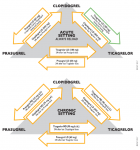
Figure 2
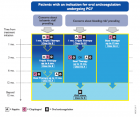
Figure 3
Similar Articles
-
Thrombolysis, the only Optimally Rapid Reperfusion TreatmentVictor Gurewich*. Thrombolysis, the only Optimally Rapid Reperfusion Treatment. . 2017 doi: 10.29328/journal.jccm.1001010; 2: 029-034
-
Incidence of symptom-driven Coronary Angiographic procedures post-drug-eluting Balloon treatment of Coronary Artery drug-eluting stent in-stent Restenosis-does it matter?Victor Voon*,Dikshaini Gumani,Calvin Craig,Ciara Cahill,Khalid Mustafa,Terry Hennessy,Samer Arnous,Thomas Kiernan. Incidence of symptom-driven Coronary Angiographic procedures post-drug-eluting Balloon treatment of Coronary Artery drug-eluting stent in-stent Restenosis-does it matter?. . 2017 doi: 10.29328/journal.jccm.1001011; 2: 035-041
-
A rare Congenital Coronary Artery Anomaly: Woven Right Coronary Artery associated with Myocardial InfarctionTolga Doğan,Mucahit Yetim,Lütfü Bekar,Oğuzhan Çelik,Macit Kalçık*,Yusuf Karavelioğlu. A rare Congenital Coronary Artery Anomaly: Woven Right Coronary Artery associated with Myocardial Infarction. . 2017 doi: 10.29328/journal.jccm.1001013; 2: 050-051
-
Is secondary prevention information before discharge adequate after percutaneous coronary intervention?Catrin Henriksson*,Joep Perk. Is secondary prevention information before discharge adequate after percutaneous coronary intervention?. . 2019 doi: 10.29328/journal.jccm.1001034; 4: 012-020
-
Single-centre real world experience of the Mynx Femoral closure device in patients undergoing percutaneous coronary interventionThirunavukarasu S,Zaman M,Hayat A,Aghamohammadzadeh R,Malik N*. Single-centre real world experience of the Mynx Femoral closure device in patients undergoing percutaneous coronary intervention. . 2019 doi: 10.29328/journal.jccm.1001036; 4: 030-035
-
Assessment of lipid and hematological profile among blood donors in European Gaza Hospital, PalestineAhmad M Tabash*,Wesam M Afana,Abdrabbou M Elregeb,Sameer Abu Eid,Ayman M Abu Mustafa. Assessment of lipid and hematological profile among blood donors in European Gaza Hospital, Palestine. . 2019 doi: 10.29328/journal.jccm.1001043; 4: 073-079
-
Severe Infantile Coarctation and Mid Aortic Stenosis in Williams SyndromeLousararian Marina,Troglia Ana,Cabrera María J,Alday Luis E*. Severe Infantile Coarctation and Mid Aortic Stenosis in Williams Syndrome. . 2019 doi: 10.29328/journal.jccm.1001044; 4: 080-082
-
Timing of cardiac surgery and other intervention among children with congenital heart disease: A review articleChinawa JM*,Adiele KD,Ujunwa FA,Onukwuli VO,Arodiwe I,Chinawa AT,Obidike EO,Chukwu BF. Timing of cardiac surgery and other intervention among children with congenital heart disease: A review article. . 2019 doi: 10.29328/journal.jccm.1001047; 4: 094-099
-
Prevalence of congenital heart diseases among primary school children in the Niger Delta Region of Nigeria, West AfricaUjuanbi Amenawon Susan*,Tabansi Petronilla Nnena,Otaigbe Barbara Edewele. Prevalence of congenital heart diseases among primary school children in the Niger Delta Region of Nigeria, West Africa. . 2019 doi: 10.29328/journal.jccm.1001056; 4: 144-149
-
Plaque morphology in diabetic vs. non diabetic patients assessed by Multi-Slice Computed Tomography coronary angiographyHesham Mohamed Aboul-Enein,Amr Elsayed El Naggar,Shereen Ibrahim Farag,Waleed Atef Ahmed Hassan*. Plaque morphology in diabetic vs. non diabetic patients assessed by Multi-Slice Computed Tomography coronary angiography. . 2019 doi: 10.29328/journal.jccm.1001057; 4: 150-155
Recently Viewed
-
Pneumothorax as Complication of CT Guided Lung Biopsy: Frequency, Severity and Assessment of Risk FactorsGaurav Raj*,Neha Kumari,Neha Singh,Kaustubh Gupta,Anurag Gupta,Pradyuman Singh,Hemant Gupta. Pneumothorax as Complication of CT Guided Lung Biopsy: Frequency, Severity and Assessment of Risk Factors. J Radiol Oncol. 2025: doi: 10.29328/journal.jro.1001075; 9: 012-016
-
The Police Power of the National Health Surveillance Agency – ANVISADimas Augusto da Silva*,Rafaela Marinho da Silva. The Police Power of the National Health Surveillance Agency – ANVISA. Arch Cancer Sci Ther. 2024: doi: 10.29328/journal.acst.1001046; 8: 063-076
-
A Comparative Study of Serum Sodium and Potassium Levels across the Three Trimesters of PregnancyOtoikhila OC and Seriki SA*. A Comparative Study of Serum Sodium and Potassium Levels across the Three Trimesters of Pregnancy. Clin J Obstet Gynecol. 2023: doi: 10.29328/journal.cjog.1001137; 6: 108-116
-
Chaos to Cosmos: Quantum Whispers and the Cosmic GenesisOwais Farooq*,Romana Zahoor*. Chaos to Cosmos: Quantum Whispers and the Cosmic Genesis. Int J Phys Res Appl. 2025: doi: 10.29328/journal.ijpra.1001107; 8: 017-023
-
Phytochemical Compounds and the Antifungal Activity of Centaurium pulchellum Ethanol Extracts in IraqNoor Jawad Khadhum, Neepal Imtair Al-Garaawi*, Antethar Jabbar Al-Edani. Phytochemical Compounds and the Antifungal Activity of Centaurium pulchellum Ethanol Extracts in Iraq. J Plant Sci Phytopathol. 2024: doi: 10.29328/journal.jpsp.1001137; 8: 079-083
Most Viewed
-
Evaluation of Biostimulants Based on Recovered Protein Hydrolysates from Animal By-products as Plant Growth EnhancersH Pérez-Aguilar*, M Lacruz-Asaro, F Arán-Ais. Evaluation of Biostimulants Based on Recovered Protein Hydrolysates from Animal By-products as Plant Growth Enhancers. J Plant Sci Phytopathol. 2023 doi: 10.29328/journal.jpsp.1001104; 7: 042-047
-
Sinonasal Myxoma Extending into the Orbit in a 4-Year Old: A Case PresentationJulian A Purrinos*, Ramzi Younis. Sinonasal Myxoma Extending into the Orbit in a 4-Year Old: A Case Presentation. Arch Case Rep. 2024 doi: 10.29328/journal.acr.1001099; 8: 075-077
-
Feasibility study of magnetic sensing for detecting single-neuron action potentialsDenis Tonini,Kai Wu,Renata Saha,Jian-Ping Wang*. Feasibility study of magnetic sensing for detecting single-neuron action potentials. Ann Biomed Sci Eng. 2022 doi: 10.29328/journal.abse.1001018; 6: 019-029
-
Pediatric Dysgerminoma: Unveiling a Rare Ovarian TumorFaten Limaiem*, Khalil Saffar, Ahmed Halouani. Pediatric Dysgerminoma: Unveiling a Rare Ovarian Tumor. Arch Case Rep. 2024 doi: 10.29328/journal.acr.1001087; 8: 010-013
-
Physical activity can change the physiological and psychological circumstances during COVID-19 pandemic: A narrative reviewKhashayar Maroufi*. Physical activity can change the physiological and psychological circumstances during COVID-19 pandemic: A narrative review. J Sports Med Ther. 2021 doi: 10.29328/journal.jsmt.1001051; 6: 001-007

HSPI: We're glad you're here. Please click "create a new Query" if you are a new visitor to our website and need further information from us.
If you are already a member of our network and need to keep track of any developments regarding a question you have already submitted, click "take me to my Query."






